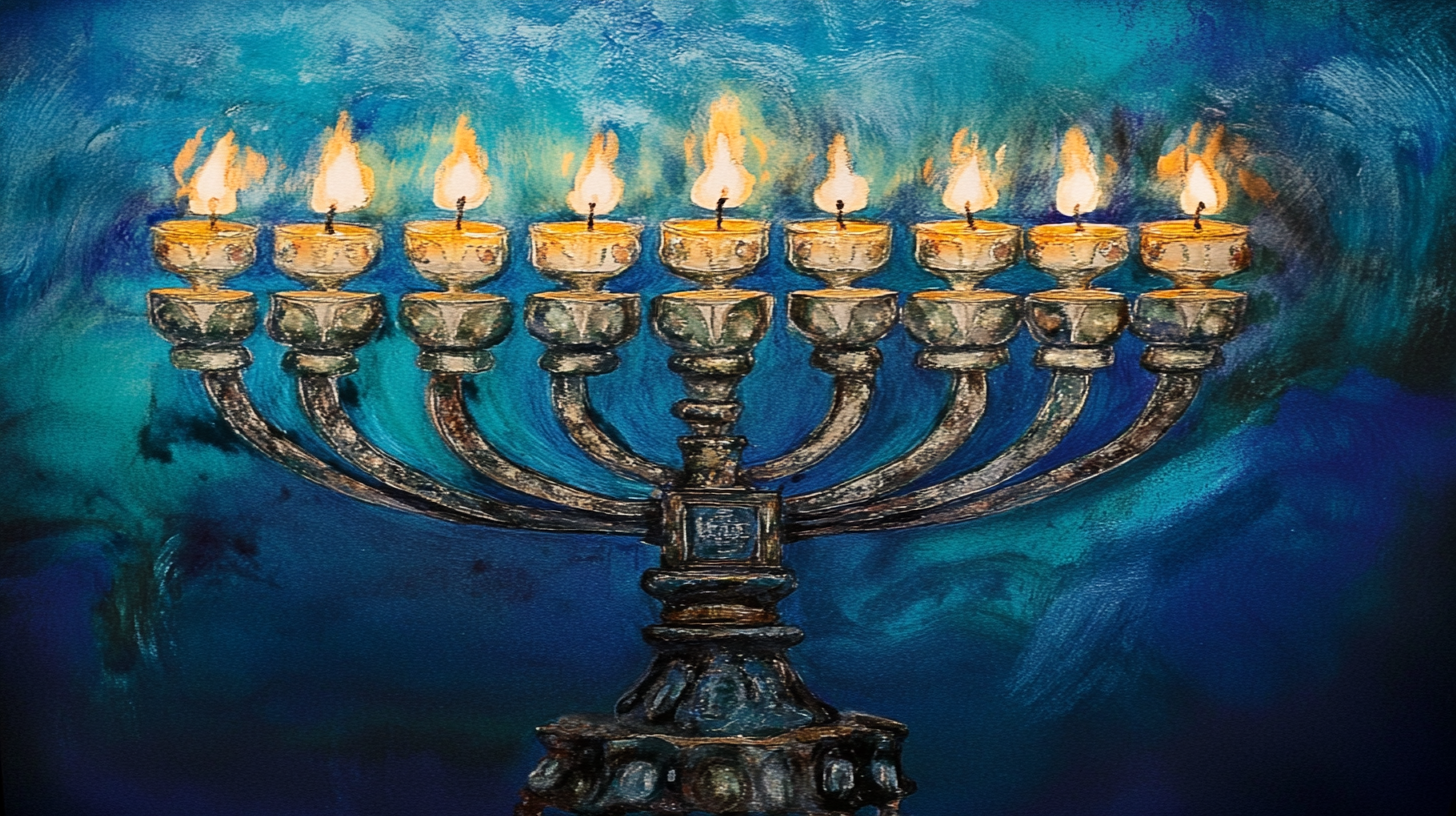The mysterious origins of the Jewish menorah may be pagan and divinely feminine!
The Menorah: Another Tree of Life?
Over the eight-day holiday of Hanukkah, Jews around the world light a menorah to commemorate a miracle that occurred in the 2nd century B.C.E. Following the successful revolt of the Maccabees and rededication of the Second Temple of Jerusalem, the temple remained illuminated for eight days. Every Hanukkah, known as the festival of lights, the Jewish people reignite the eight-branched candelabra, with a ninth “shamash” candle. This is a symbol of a Jewish triumph in the face of religious oppression.
Strange then, that the origins of the menorah are not textually secure. Even its purportedly pagan beginnings aren’t clearly defined. Given that Hanukkah falls during the winter solstice, there could be a logical theoretical link between the Jewish and pagan holidays. Weaving through the historical references, amazingly, the symbol may trace back to Judaism’s own pagan history – a mother goddess named Asherah. She is often represented with a tree of life or as one. On the one hand, the menorah is an emblem of religious freedom. On the other, it may, if its matriarchal roots are true, symbolize the suppression of the divine feminine by patriarchal values.
The Maccabeans
In the 6th century B.C.E., the Persian emperor Cyrus the Great let the Jews return to their homeland after spending decades in exile in Babylon. The Persians allowed the Jews to govern Judea as a semi-autonomous theocracy run by elite religious families in Jerusalem. Their religious freedom would remain intact under the jurisdiction of Alexander the Great, the Ptolemaic kingdom (Egyptian) and the Seleucid Empire in the north. However, once Antiochus IV Epiphanes became emperor of the Seleucid Empire in 175 B.C.E. that changed.
Antiochus might have had “daddy issues” or wanted to take his father’s legacy to the next level – who knows – but he had his vision set on conquering Egypt. In doing so, he would have achieved a feat his father did not – unite the Egyptian and Seleucid empires. But he needed money. Where else would you go other than the priests? As the Notorious B.I.G. said, “mo’ money mo’ problems.” This exchange of money for power between governmental and religious leaders ended up causing much discord between the Jewish people and the Hellenistic and Jewish faiths. Antiochus elected the highest bidder, Menelaus, who then attempted to Hellenize the Jews.
Ding Dong Antioch is Dead…Just Kidding…
First, Antiochus invaded Egypt, which was a catastrophic move. Rumors spread throughout the kingdom that he died in battle. Far from it, the Romans merely humiliated him and kicked him out of Egypt. Meanwhile, the news of his “death” led to a civil revolt in Jerusalem. This news disturbed Antiochus. As a result, he put Menelaus back in power, who then raised all hell for the Jews. Some Jews fled, others revolted. The most famous rebels were led by Mattathias of Modiin and his five sons. Out of all of them, Judas Maccabeus would be the one responsible for leading the rebel forces to victory. They went – guerilla style – after the Hellenized Jews, which cued Menelaus to send in the Greek troops. The situation escalated, and the plight of the rebel Jews reached dire straits.
In 168 B.C.E., Antioch’s troops descended upon Jerusalem. They massacred thousands and desecrated the city’s second holy temple by erecting an altar for Zeus and sacrificing pigs within its walls as a festively offensive act. The rebel Jews, however, were eventually victorious in driving the Greek-Syrians out of Jerusalem. Afterward, the Jewish people rededicated the Second Temple, and while doing so witnessed a miracle. There was only enough oil in the lamps to last a day. It kept on burning bright for eight days. The commemoration of this event became known as Hanukkah.
Where’s the Menorah?
The earliest textual reference to Hanukkah appears in 1 Maccabees. No mention of a menorah. No particular guidance on how to celebrate the holiday either. In 500 C.E.– during the Talmudic times – the practice of lighting menorahs was firmly established. The actual origins of the menorah itself are then somewhat mysterious. One theory purports that Jewish households derived this symbol from pagan winter solstice rituals, specifically the Zoroastrians of Persia. At this time of year, they celebrated with a “festival of fire.” Hanukkah, date-wise, surrounds the winter solstice. The menorah could be a solar symbol, with the lighting of the candles corresponding to the days growing longer.
However, startling archeological evidence exists that may link the menorah to a pre-Judeo-Christian deity – the Semitic Mother Goddess Asherah. A Canaanite goddess! If anyone knows anything about the Judeo-Christians, Canaanites are the evil pagans.
Asherah: The Tree of Life
Jewish scholar L. Yarden claims that the menorah developed from the Ancient Near Eastern symbolic Tree of Life that traces back to 2300-2500 B.C.E. The image consisted of Mesopotamian trees with seven branches that included decorative motifs of a snake and two figures. In its personified form, the Tree of Life is Asherah, a nurturing mother goddess.
In her book, Reinstating the Divine Feminine into Judaism, Jenny Klein presents Asherah. She is a Semitic Mother Goddess that represents the divine feminine. Asherah’s own iconography included images of trees. Furthermore, there is evidence that Asherah may have even been the female consort to the Hebrew God Yahweh. In the early history of Judaism however, the chief gods, Yahweh and Ba’alshamem, were fighting for supreme power. Judaism around this time diverged from other ancient Near East religions. At that time, they eradicated the feminine from the divine equation.
Menorah: Divinely Feminine?
The menorah, today, is a symbol of the state of Israel appearing on its coat of arms. It is of utmost importance to the Jewish people. However, symbols don’t appear out of anywhere. The historical context surrounding this powerful image is blurry.
There are hints of winter solstice ideas surrounding the ritual of Hanukkah itself. Far from being offensive, this triumphant moment in Jewish history happens to coincide with a time associated with the rebirth of the sun. Coincidence? Beyond the foreign, pagan rituals that might have influenced this holiday, it appears more promising to look at the pagan origins of their own lineage.
Within the big three monotheistic religions, the dominance of the patriarch is evident, whereas fertility goddesses of yore tended to populate more ancient belief systems. The first image that may come up in a History of Western Art class was the Venus of Willendorf. We’re a little too far from college to know if that remains the case, but it does reflect a definitive shift away from the feminine, or even an acknowledgment that the feminine is there, to a male-dominated narrative.
The Tree of Life seems to be at the root of many belief systems. In this case, in the Near Eastern faiths, including Judaism, the almond tree was the Tree of Life that Asherah embodies. For Hanukkah this year, we light a candle for the victory of the Jewish people and as a symbol of the enduring spirit of the feminine.













